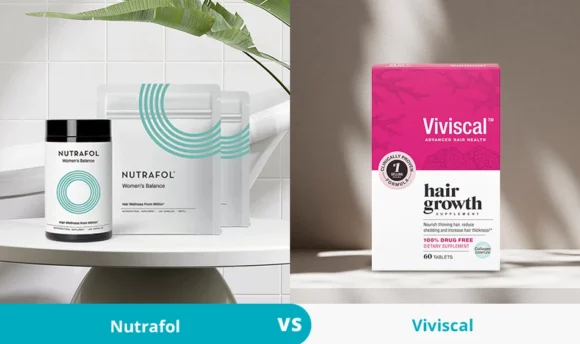Vitamin D for Hair Loss: How Deficiency Can Transform Your Locks
A lack of vitamins and minerals can have drastic effects on your hair, contributing to dry, brittle strands and patchy hair loss. Could low levels of vitamin D be to blame? Learn why you need vitamin D in your diet to support hair follicle health and well-maintained locks.

Hair loss can immediately instill worry and fear. Nobody wants to lose their hair prematurely, and finding the cause can quickly feel like a never-ending task.
While multiple things can cause your hair to thin or fall out, it comes down to nutrition in many cases. It’s possible that a lack of vitamins and minerals is to blame, especially if you’re deficient in those that play a role in the hair growth process, such as vitamin D.
Could the cause of your hair loss come down to a vitamin D deficiency? Discover the truth behind vitamin D and hair health, as well as how to boost levels of the much-needed vitamin.
Vitamin D for Hair Loss: What Does It Mean?
Low levels of vitamin D in your body’s system can disrupt the hair growth cycle and lead to hair loss and other hair issues. Vitamin D for hair loss means taking supplements or eating foods to correct a vitamin D deficiency, thereby treating hair loss.
Identifying and amending a nutritional deficiency is vital if you want to restore hair growth and prevent further hair loss.
Vitamin D and Hair Health: How Are They Related?
Vitamin D is a fat-soluble vitamin that you need to function correctly. It is responsible for helping your body absorb calcium and phosphorus to build and maintain strong bones. These nutrients are essential for protecting against osteoporosis – a bone disease that weakens the bones.
A chronic vitamin D deficiency can result in low calcium levels in the blood, a condition called hypocalcemia. This can also contribute to muscle aches and spasms, dry skin, brittle nails, and more coarse hair than usual.
You also need enough vitamin D for normal muscle function, stimulating cell growth, carrying messages between the brain and body, and supporting the immune system.
In terms of hair health, vitamin D supports hair follicle cycling by making new hair follicles. The cycle can stall and stunt hair growth when you don’t have enough in your system.
Vitamin D also stimulates skin cells called keratinocytes, which produce keratin, a necessary protein for keeping the skin, hair, and nails healthy.
The disruption to the normal hair cycle is associated with alopecia areata – an autoimmune condition where hair loss occurs as the immune system attacks the hair follicles.
As well as alopecia areata, low vitamin D levels are linked to female hair loss in those with telogen effluvium or female pattern hair loss.
How to Know if You’re Vitamin D Deficient
Many people with vitamin D deficiency show no signs or symptoms. Those presenting symptoms might have bone pain, fractures, fatigue, mood changes, muscle twitching, weakness, aches, and cramps. In older adults, vitamin D deficiency may increase the risk of falls.
So, if you’re feeling exhausted and your bones and muscles hurt, it could indicate a vitamin D deficiency.
Can Vitamin D Deficiency Cause Hair Loss?
Yes, vitamin D deficiencies can lead to hair loss. You need enough vitamin D to maintain healthy hair because it significantly influences the hair growth cycle. It stimulates the hair follicles to grow, and without it, you might find that hair growth slows or stops entirely.
In fact, low vitamin D levels are linked to scarring and non-scarring alopecias, including telogen effluvium, androgenetic alopecia, and alopecia areata – disorders where hair loss is the key characteristic.
#1 How to tell if you’re experiencing hair loss
Hair loss happens when your hair stops growing – it falls out, and there is no new hair to replace it. If you are experiencing hair loss, you might notice thinning hair on the top of your head, bald patches, or a receding hairline.
It differs from hair shedding, which is a temporary condition that causes excessive hair fall, but the hair follicles continue to produce new hair. It’s normal to lose 50–100 hairs per day, and you generally won’t notice, whereas a hair loss disorder causes significant hair fall.
It can be tricky to differentiate between hair loss and hair shedding. If you are unsure, a dermatologist can examine your hair to confirm.
#2 Can vitamin D hair loss be reversed?
Yes! Hair loss as a result of a vitamin D deficiency is reversible. Correcting this nutritional deficiency with vitamin D administration is an effective hair loss treatment that aids hair regrowth. You can expect the hair follicles to resume normal function with a healthy vitamin D level.
Remember to remain patient while waiting for your hair to grow back. It might take around two to three months for hair regrowth to occur following a vitamin deficiency.
How to Treat Vitamin D-Related Hair Loss
Vitamin D deficiency is curable. So, taking action to boost your vitamin D levels will simultaneously treat your hair loss. Eating a healthy diet, taking dietary supplements, getting outside, and selecting the right cosmetics are simple strategies you can implement daily.
Let’s look at these methods in more detail.
#1 Eat vitamin D-rich foods
The first thing to do is adjust your diet. You might not get adequate vitamin D from food alone. This is especially true for people living in the north with less sunshine, who are more likely to become deficient. Still, you can get some of your daily intake from dietary sources.
Consuming foods rich in vitamin D will boost your blood levels while providing you with other vitamins and minerals for good health.
The best dietary sources include oily and fatty fish like salmon, sardines, herring, and mackerel. Egg yolks, red meat, sun-exposed mushrooms, spinach, and kale are other good choices for a vitamin D-rich diet.
#2 Take vitamin D supplements
The next step is to add a dietary supplement to your regimen. This will ensure you get the appropriate amount of vitamin D daily without monitoring your diet or worrying about the weather.
Supplements contain two forms of vitamin D – vitamin D2 (ergocalciferol) and vitamin D3 (cholecalciferol). Both types work to increase your levels, although vitamin D3 is considered the most effective.
As a fat-soluble vitamin, it absorbs into your bloodstream best when paired with foods containing fat. So, try taking your supplement with a high-fat meal or snack to enhance results.
Research suggests a combination of oral vitamin D supplementation and topical Minoxidil works better than one alone.
#3 Get in the sun
Vitamin D is rightly known as the “sunshine vitamin” because your skin produces it during sun exposure. Not getting enough sunlight is one of the leading causes of deficiency and may occur if you spend too much time indoors or live in a climate with limited sunlight.
Studies show that exposing your skin to sunlight at midday is most effective for vitamin D production, particularly in the summer months. You could swap your morning walks for strolls at noon or take your lunch break outdoors.
#4 Use topical treatments
Using a vitamin D topical treatment may help to regrow hair follicles. Additionally, vitamin D deficiencies can contribute to an autoimmune condition called scalp psoriasis that causes dry, itchy, and scaly patches of skin on the scalp. Sometimes, it can also trigger temporary hair loss.
Applying topical creams directly to the scalp can address this issue while delivering vitamin D to the bloodstream and raising levels. Studies show vitamin D via the dermal route can help treat deficiency.
FAQs
Hair loss may occur within a few weeks or months of developing a vitamin D deficiency. The effects tend to be gradual as your hair follicles move through a cycle. The longer your body is deficient in vitamin D, the more likely you are to experience hair loss.
The daily vitamin D recommendation for adults to remain healthy is 600 IU daily. This will ensure you have sufficient vitamin D levels to enable hair growth. However, how much vitamin D you need exactly depends on factors like age, sun exposure, and the season.
After boosting your serum vitamin D levels, you may notice your hair stops falling within a couple of months. That said, there is insufficient evidence to confirm how quickly hair loss stops after correcting vitamin D deficiency.
A Word From a Trichologist
A vitamin D deficiency is a common cause of hair loss. It’s relatively easy to develop a deficiency if you do not get enough vitamin D from your diet and sunlight. As well as hair thinning, lacking this nutrient primarily causes bone and muscle problems.
Thus, discovering and correcting a vitamin D deficiency is essential.
Alongside taking a vitamin D supplement and eating the right foods, you can also focus on other dietary sources with advantages for your hair. Choosing foods with iron, zinc, fatty acids, and vitamins A, B, and E will support healthy hair growth.
Some self-care tips can help you hold onto a healthy head of hair and encourage your hair to grow faster. For example, maintaining a healthy scalp, massaging your scalp to stimulate blood flow, and choosing the right cosmetics can help stimulate hair growth.
Conclusion
Vitamin D deficiency hair loss is distressing, but you can counter it with oral supplements and good nutrition. But before filling your diet with vitamin D supplements and foods, talk to your doctor. You need to make sure that vitamin D deficiency is really behind your hair loss.
Without a proper diagnosis, you might boost your levels and witness zero changes to your hair health. You might have other vitamin deficiencies that need addressing to mitigate hair loss.

















































 Select your language:
Select your language: 








